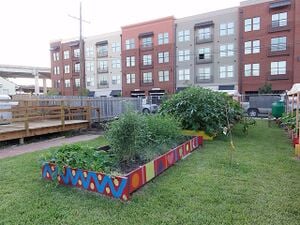
 The sinking Louisiana town of Isle de Jean Charles was forced to pack up and move to safer ground. Many more US towns may soon need to follow in their footsteps, bbc.com/future (Jan 30, 2024)
The sinking Louisiana town of Isle de Jean Charles was forced to pack up and move to safer ground. Many more US towns may soon need to follow in their footsteps, bbc.com/future (Jan 30, 2024)
Environment quality
The Louisiana Bucket Brigade is a 501(c)(3) nonprofit environmental health and justice organization based in New Orleans, Louisiana. Founded in 2000 by Anne Rolfes, the organization works with communities neighboring state oil refineries and chemical plants to address air quality issues.
Coasts
Coalition to Restore Coastal Louisiana
Community involvement
Neighborland, New Orleans
Community energy
Solar power in Louisiana is ranked 34th for installed solar PV capacity as of 2017 by the Solar Energy Industry Association. The state's "solar friendliness" according to Solar Power Rocks has fallen to 50th place for 2018 as the state credit program ends and full 1:1 retail net metering is being phased out. Taxpayers still benefit from federal incentive programs such as the 30 percent tax credit, which applies to business and residential solar photovoltaic and thermal energy systems of any size.
Google's Project Sunroof estimates Louisiana to have over 20GW of rooftop solar potential, of which New Orleans is estimated to have over 90% of its roofs capable of solar energy production.
Cycling activism
Critical Mass, Baton Rouge on facebook - Wikipedia: Bike paths in Louisiana (category)
Food activism
New Orleans Food & Farm Network
Sustainable transport
The Tammany Trace is a rail trail in St. Tammany Parish, Louisiana, occupying a former Illinois Central Railroad corridor.
It has been developed into a 31-mile (50 km) asphalt trail for hiking, cycling, and wheelchair use. Some parts of the Trace include a separate equestrian pathway suitable for horse riding.
It connects Covington, Abita Springs, Mandeville, Lacombe, and Slidell, running along the northern shore of Lake Pontchartrain. The trail was damaged by Hurricane Katrina in 2005, but was reopened by early 2007. The Trace is easily accessible from Fontainebleau State Park.
Resources
Events
2014
April 19 New Orleans Earth Day Festival
Citizens data initiative
News and comment
2023
 ‘We needed to get off the grid’: New Orleans’ community-driven response to blackouts, theguardian.com (Nov 16, 2023)
‘We needed to get off the grid’: New Orleans’ community-driven response to blackouts, theguardian.com (Nov 16, 2023)
2017
New Orleans — "Biking Boomtown" — Doubled Rate Of Bicycle Commuters In 10 Years, Apr 21[1]
About Louisiana
Louisiana (French: Louisiane [lwizjan] ; Spanish: Luisiana [lwiˈsjana]; Louisiana Creole: Lwizyàn) is a state in the Deep South and South Central regions of the United States. It borders Texas to the west, Arkansas to the north, and Mississippi to the east. Of the 50 U.S. states, it ranks 20th in land area and the 25th in population, with roughly 4.6 million residents. Reflecting its French heritage, Louisiana is the only U.S. state with political subdivisions termed parishes, which are equivalent to counties, making it one of only two U.S. states not subdivided into counties (the other being Alaska and its boroughs). Baton Rouge is the state's capital, and New Orleans, a French Louisiana region, is its largest city with a population of about 383,000 people. Louisiana has a coastline with the Gulf of Mexico to the south; a large part of its eastern boundary is demarcated by the Mississippi River.
Much of Louisiana's lands were formed from sediment washed down the Mississippi River, leaving enormous deltas and vast areas of coastal marsh and swamp. These contain a rich southern biota, including birds such as ibises and egrets, many species of tree frogs—such as the state recognized American green tree frog—and fish such as sturgeon and paddlefish. More elevated areas, particularly in the north, contain a wide variety of ecosystems such as tallgrass prairie, longleaf pine forest and wet savannas; these support an exceptionally large number of plant species, including many species of terrestrial orchids and carnivorous plants. Over half the state is forested.
Louisiana is situated at the confluence of the Mississippi river system and the Gulf of Mexico. Its location and biodiversity attracted various indigenous groups thousands of years before Europeans arrived in the 17th century. Louisiana has eighteen Native American tribes—the most of any southern state—of which four are federally recognized and ten are state recognized. The French claimed the territory in 1682, and it became the political, commercial, and population center of the larger colony of New France. After a brief period of Spanish rule, Louisiana was returned to France in 1801 before being purchased by the U.S. in 1803; it was admitted to the Union in 1812 as the 18th state.
Following statehood, Louisiana saw an influx of settlers from the eastern U.S. as well as immigrants from the West Indies, Germany, and Ireland. It experienced an agricultural boom, particularly in cotton and sugarcane, which were cultivated primarily by slaves imported from Africa. As a slave state, Louisiana was one of the original seven members of the Confederate States of America during the American Civil War.
References
